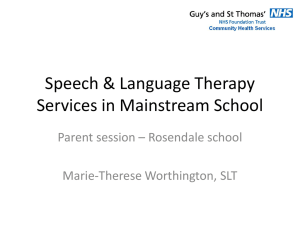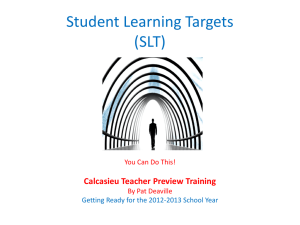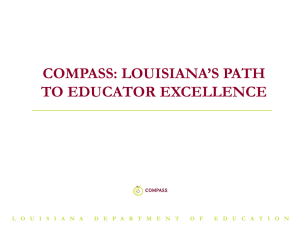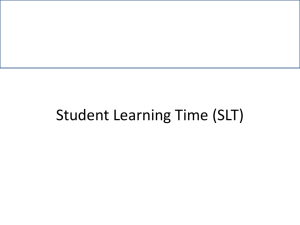Student Learning Targets Short Combined
advertisement
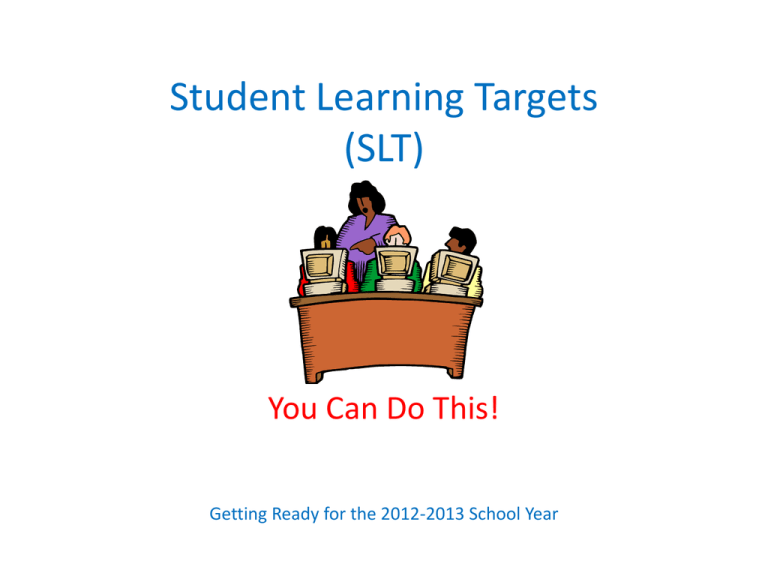
Student Learning Targets (SLT) You Can Do This! Getting Ready for the 2012-2013 School Year SLT Annual Timeline Louisiana Department of Education • Summer: Districts determine strategy for standardizing targets and/or assessments and develop support system for teachers and evaluators. • Beginning of School Year: Teachers set at least two targets and define what performance will look like at each level of effectiveness. Evaluators approve targets based on three criteria. • Mid-Year: Teachers and evaluators monitor progress towards targets: Teachers and evaluators update targets, if assignment or student population changes significantly. • End of School Year: Evaluators assign teachers a final rating based on students’ progress towards target, using the agreed upon definitions of effectiveness from the beginning of the year. Student Learning Targets (SLT) You Can Do This! Awareness Understanding the SLT Process TIPS on Keeping Your Sanity Don’t let it all get to you before you even start! Hold Hands • Link “compliance” with “common sense.” • Compliance with laws, policy and regulations are important. • But application of common sense is equally important. • Use your expertise, experience, and resources to make the initial implementation of SLTs a “doable” thing for teachers and evaluators. What is a Student Learning Target (SLT)? • A student learning target (SLT) is a measurable goal for student achievement over a given period of time. • SLTs should be driven by baseline data on where students are performing. • SLTs should be aligned with the appropriate standards for the course. • SLTs should be measurable by a pre-determined assessment. What else should I know about SLTs? • An SLT is not a compilation of everything you teach in your class. • An SLT does not need to include every student that you teach. • An SLT focuses on one or more critical learning objectives within the full range of what students are expected to learn. • There must be a valid rubric that determines proficiency of the student. • There should also be a gathering of evidence of student progress over time (body of evidence) between the initial assessment and final assessment or aggregation of final results. Who Writes an SLT? • Teachers of grades and subjects that are not tested via the state’s current annual standardized testing program. OR • Teachers in a grade and/or subject area where there is no prior year’s assessment data available for their students from the state’s current annual standardized testing program. THEREFORE • The student growth component of the evaluation for this group of teachers will be based predetermined Student Learning Targets (SLT • LDOE and LEAs shall require all teachers to become involved in the SLT writing process, but the student growth for the evaluation would continue to come from VAM for VAM teachers. When is the SLT written? • Establishing the SLTs (Beginning of the School Year) • Teachers set at least two targets and define what performance will look like at each level of effectiveness • Evaluators approve targets based on three criteria, using a standard rubric, to ensure they contain: Priority Content Rigor High-Quality Evidence • Teachers whose targets do not meet these criteria will be asked to revise the targets. Who is the Target Audience of the SLT? • Teachers may set targets focused on an entire class/a specific subject/a cohort or their lowest performing students. • The target audience is not necessarily every student taught by the teacher. • The teacher and evaluator may collaboratively select a grade level or subject as the target audience so long as the grade level or subject is representative of a cross-section of all student taught by the teacher. How is the SLT Developed? • Ideally, the SLT will be teacher-created and individualized to the course taught by the teacher with the understanding that the SLT is subject to review and rating by an evaluator. • The school district may allow teachers and administrators to establish SLTs collaboratively at the school level. • A school or school district has the authority to standardize SLTs at grade levels, in specific courses, or in specific subject areas if it is determined that standardization is in the best interest of the school or school district. Does the teacher develop the SLT in Isolation? • The teacher should become familiar with the LDOE /LEA guidelines and parameters before beginning the process of writing. • Some District decisions may alter the parameters of the SLT through standardization of assessments and/or critical learning objectives. • The teacher should become familiar with SLT samples provided by the LDOE and LEA. • The teacher is encouraged to work in collaboration with other teachers and supervisors. • The teacher is encouraged to consult with their evaluator during the development process. How is the SLT rated ? • Rating the SLT (End of Year) • Evaluators assign teachers a final rating based on students’ progress towards target, using the agreed upon definitions of effectiveness from the beginning of the year Insufficient Attainment of Target (1) Partial Attainment of Target (2) Full Attainment of Target (3) Exceptional Attainment of Target (4) Achievement Ranges Sample Based on 60 Students and 70% Achieving Target Goals Insufficient Attainment is any result below Partial Attainment. (1 point) 32 or fewer students out of the 60 students in the target audience Partial Attainment is a range from 10-15% below the target to just below the actual SLT. (2 points) 33-41 students out of the 60 students in the target audience START HERE: Full Attainment is a range from the actual SLT up to 10-15% above the target. (3 points) 70% of 60 students - 42-51 students out of the 60 students in the target audience. Exceptional Attainment is any result above the Full Attainment range. This range should represent more than a year’s worth of growth. (4 points) 52 or more students out of the 60 students in the target audience. How does the SLT enter into the Teacher’s Evaluation? SLT Score within Overall COMPASS Evaluation • Evaluators assign a rating of 1, 2, 3, or 4 to each SLT, based on the standard rubric and pre-determined performance descriptions for each SLT. • SLT scores are averaged to arrive at a final SLT score for the teacher that year. • The final SLT score is used as the student growth score for the teacher at the end of the year, which will be averaged with the final professional practice score to arrive at the overall Compass rating. Student Learning Targets (SLT) You Can Do This! Writing An SLT A Step-By-Step Process Start with What You Already Know and Do. • What do you expect the students to learn in your class? • Do your expectations align with established GLEs, local, state, national or professional standards? • How do you assess students in measuring learning and proficiency? Select a Focal Point for Your SLT. Defining the Content • Select critical learning objectives within the broad range of all the things you expect students to learn in the course/subject. • These critical learning objectives must align with established GLEs or national/state/local standards/benchmarks. • Critical learning objectives selected should be central to the content of the course. Proficiency in these should correlate with mastery of the central purpose of the course/subject. • In other words, if the student is proficient in these critical learning objectives, the student is very likely to be proficient in the course/subject as a whole. Identify Your Target Audience • Teachers may set targets focused on an entire class/a specific subject/a cohort or their lowest performing students. • The target audience is not necessarily every student taught by the teacher. • The teacher and evaluator may collaboratively select a grade level or subject as the target audience so long as the grade level or subject is representative of a cross-section of all student taught by the teacher. Assessing is Critical to the SLT Find the right assessment(s) for the content you have chosen. • The critical learning objectives of your SLT must be measurable for proficiency by an assessment that is both valid and rigorous. • If an appropriate common assessment is not available and a teacherdesigned assessment is not feasible, then you have chosen the wrong learning objectives for your SLT. • Go back to square one and select readily measurable learning objectives if the original learning objectives you selected were too vague or not clearly measurable. Use Baseline Data • Baseline data about where students are beginning the year is important to helping teachers set goals that are rigorous for their particular group of students. • Such data can be gathered through pre-assessments, diagnostic tests, or end-of-year assessments from the previous year. Set the Expectation for Growth & Provide Rationale • Take baseline data into account to set a goal that is challenging, but attainable) • Agree upon a scoring plan with your evaluator after setting the target Four Components of a Quality SLT • RATIONALE FOR SLT What are the critical learning objectives, the content standards aligned to those objectives, and the assessment plan to be used in measuring student growth. • STUDENT LEARNING TARGET Clear statement of the statistical projection of student growth in meeting a preestablished goal. • BASELINE DATA Information about the target audience gathered by the teacher to establish the performance/skills/achievement levels at the beginning of the year as relates to the critical learning objectives. • SCORING PLAN AND ACHIEVEMENT RANGE Clear statement of the ranges of achievement that demonstrate the teacher’s impact on students meeting a pre-established goal. Three Key Characteristics of Strong SLTs SLTs are approved by the evaluator using these three criteria items: • Priority Content: SLT focuses on learning content that is aligned to state and/or common core standards (when applicable). • Rigor: The numerical target represents an appropriate amount of student learning (challenging, yet attainable) for the specified interval of instruction and the specified set of students. • High-Quality Evidence: SLT assessment provides data from the beginning and end of students' time with teacher and is based on a common assessment when available, or meets assessment criteria if not.
